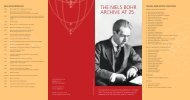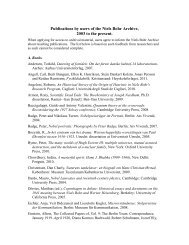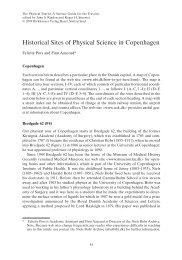One hundred years of the Bohr atom - Niels Bohr Archive - Niels ...
One hundred years of the Bohr atom - Niels Bohr Archive - Niels ...
One hundred years of the Bohr atom - Niels Bohr Archive - Niels ...
You also want an ePaper? Increase the reach of your titles
YUMPU automatically turns print PDFs into web optimized ePapers that Google loves.
Programme for <strong>the</strong> history <strong>of</strong> science conference<br />
<strong>One</strong> <strong>hundred</strong> <strong>years</strong> <strong>of</strong> <strong>the</strong> <strong>Bohr</strong> <strong>atom</strong><br />
Tuesday 11 to Friday 14 June 2013<br />
Tuesday 11 June<br />
18:00 Arrival, registration and reception for invited speakers<br />
8:45<br />
9:00<br />
9:30<br />
10:00<br />
Finn Aaserud, <strong>Niels</strong> <strong>Bohr</strong> <strong>Archive</strong>,<br />
Denmark<br />
Wednesday 12 June<br />
Welcome and practical matters<br />
Session 1: <strong>Bohr</strong> and <strong>the</strong> <strong>atom</strong> (chair, Finn Aaserud)<br />
Helge Kragh, University <strong>of</strong> Aarhus,<br />
Denmark<br />
Jaume Navarro, University <strong>of</strong> <strong>the</strong> Basque<br />
Country, Spain<br />
Michael Eckert, Deutsches Museum,<br />
Germany<br />
10:30 C<strong>of</strong>fee<br />
11:00 Michiyo Nakane, Kawasaki, Japan<br />
11:30<br />
12:00<br />
Robert Rynasiewicz, Johns Hopkins<br />
University, U.S.A.<br />
Martin Jähnert, Max Planck Institute for<br />
<strong>the</strong> History <strong>of</strong> Science<br />
12:30 Lunch<br />
14:00<br />
The many faces <strong>of</strong> <strong>the</strong> <strong>Bohr</strong> <strong>atom</strong><br />
Plum puddings and <strong>Bohr</strong>’s <strong>atom</strong><br />
Extending <strong>Bohr</strong>: Sommerfelds’s early <strong>atom</strong>ic<br />
<strong>the</strong>ory, 1913‒1916<br />
<strong>Bohr</strong>’s introduction to action-angle variables in<br />
a 1918 paper<br />
The(?) Correspondence Principle<br />
The Correspondence Principle in Practice: Its<br />
Spread and Use in <strong>the</strong> Old Quantum Theory<br />
Session 2: <strong>Bohr</strong>, <strong>the</strong> <strong>atom</strong> and o<strong>the</strong>r physics (chair, Helge Kragh)<br />
Anthony Duncan, University <strong>of</strong><br />
Pittsburgh and Michel Janssen, University<br />
<strong>of</strong> Minnesota, U.S.A.<br />
14:30 Luis Boya, University <strong>of</strong> Zaragoza, Spain<br />
15:00<br />
Enric Canals and Blai Pie Valls,<br />
University <strong>of</strong> Barcelona, Spain<br />
15:30 C<strong>of</strong>fee<br />
16:00<br />
16:30<br />
17:00<br />
Jeroen van Dongen, Utrecht University,<br />
Holland<br />
Brigitte van Tiggelen, Lovain Catholic<br />
University, Belgium, and Annette<br />
Lykknes, Norwegian University <strong>of</strong><br />
Science and Technology, Norway<br />
Thiago Hartz and Olival Freire, Federal<br />
University <strong>of</strong> Bahia, Brazil<br />
17:30 End <strong>of</strong> session<br />
Stark contrasts between <strong>the</strong> Old and <strong>the</strong> New<br />
Quantum Theory<br />
Arnold Sommerfeld and <strong>Niels</strong> <strong>Bohr</strong>:<br />
Comparison <strong>of</strong> <strong>the</strong> schools at Munich and<br />
Copenhagen at <strong>the</strong> time <strong>of</strong> <strong>the</strong> Old Quantum<br />
Theory<br />
Ehrenfest’s Adiabatic Hypo<strong>the</strong>sis in <strong>Bohr</strong>’s<br />
quantum <strong>the</strong>ory<br />
Communicating <strong>the</strong> Heisenberg Relations:<br />
<strong>Niels</strong> <strong>Bohr</strong> and <strong>the</strong> forgotten Einstein‒ Rupp<br />
Experiments<br />
Ida Noddack and <strong>the</strong> fission proposal: The<br />
actor’s perspective<br />
Uses and appropriations <strong>of</strong> <strong>Niels</strong> <strong>Bohr</strong>’s ideas<br />
about quantum field measurements, 1935‒<br />
1965.
9:00<br />
9:30<br />
10:00<br />
Thursday 13 June<br />
Session 3: Philosophical and contemporary aspects (chair, Jeroen van Dongen)<br />
Ernst Peter Fischer, Heidelberg,<br />
Germany<br />
Giora Hon, University <strong>of</strong> Haifa, Israel,<br />
and Bernard R. Goldstein, University <strong>of</strong><br />
Pittsburgh, U.S.A.<br />
Theodore Arabatzis and Despina<br />
Ioannidou, University <strong>of</strong> A<strong>the</strong>ns, Greece<br />
10:30 C<strong>of</strong>fee<br />
11:00<br />
11:30<br />
12:00<br />
Henrik Zinkernagel, University <strong>of</strong><br />
Granada, Spain<br />
N.D. Hari Dass, Chennai Ma<strong>the</strong>matical<br />
Institute, India<br />
Shan Gao, University <strong>of</strong> Sydney, Australia<br />
and Chinese Academy <strong>of</strong> Sciences, China<br />
12:30 Lunch<br />
A romantic understanding <strong>of</strong> <strong>atom</strong>s: <strong>Bohr</strong>’s<br />
success in a new perspective<br />
Constitution, structure, system, and model:<br />
Imagining <strong>the</strong> <strong>atom</strong> – an early twentieth<br />
century story<br />
The role <strong>of</strong> models and analogies in <strong>the</strong> <strong>Bohr</strong><br />
Atom<br />
<strong>Bohr</strong> and quantum fundamentalism<br />
The Superposition Principle in Quantum<br />
Mechanics – did <strong>the</strong> rock enter <strong>the</strong> foundation<br />
surreptitiously?<br />
How do electrons move in <strong>atom</strong>s? ‒ From <strong>the</strong><br />
<strong>Bohr</strong> model to quantum mechanics<br />
Session 4: National and institutional aspects (chair, Henrik Zinkernagel)<br />
14:00 Shaul Katzir, Tel Aviv University, Israel<br />
14:30<br />
15:00<br />
Gábor Palló, Budapest University <strong>of</strong><br />
Technology and Economics, Hungary<br />
Peter Robertson, University <strong>of</strong><br />
Melbourne, Australia<br />
15:30 C<strong>of</strong>fee<br />
16:00<br />
16:30<br />
Karl Grandin, Royal Academy <strong>of</strong><br />
Science, Sweden<br />
Henrik Knudsen, University <strong>of</strong> Aarhus,<br />
Denmark<br />
17:00 End <strong>of</strong> session<br />
18:30 Conference dinner for invited speakers<br />
9:30<br />
10:00<br />
Finn Aaserud, <strong>Niels</strong> <strong>Bohr</strong> <strong>Archive</strong>,<br />
Denmark<br />
Megan Shields Formato, Harvard<br />
University, U.S.A.<br />
10:30 C<strong>of</strong>fee<br />
11:00<br />
11:30<br />
12:00<br />
Friday 14 June<br />
Manchester at war: Ru<strong>the</strong>rford, <strong>Bohr</strong>,<br />
submarine detection and <strong>atom</strong>ic spectra<br />
The <strong>Bohr</strong> model’s early reception in Hungary:<br />
Hevesy and <strong>Bohr</strong><br />
Birthplace <strong>of</strong> a new physics ‒ <strong>the</strong> early history<br />
<strong>of</strong> <strong>the</strong> <strong>Niels</strong> <strong>Bohr</strong> Institute<br />
<strong>Niels</strong> <strong>Bohr</strong> from a Swedish perspective<br />
Pursuing common cultural ideals: <strong>Niels</strong> <strong>Bohr</strong>,<br />
neutrality, and international scientific<br />
collaboration during <strong>the</strong> inter-war period<br />
Session 5: O<strong>the</strong>r aspects (chair, Henrik Knudsen)<br />
Dieter H<strong>of</strong>fmann, Max Planck Institute<br />
for History <strong>of</strong> Science, Germany<br />
Arne Schirrmacher, Humboldt<br />
University, Germany<br />
Kristian H. <strong>Niels</strong>en, University <strong>of</strong><br />
Aarhus, Denmark<br />
12:30 Lunch<br />
Love and physics: Margre<strong>the</strong> Nørlund and <strong>Niels</strong><br />
<strong>Bohr</strong>’s scientific creativity, 1910‒1913<br />
Writing <strong>the</strong> <strong>atom</strong>: Writing practices and <strong>the</strong> <strong>Bohr</strong><br />
Atom<br />
The relationship between <strong>Niels</strong> <strong>Bohr</strong> and Max<br />
Planck<br />
Models at an exhibition: The planetary <strong>atom</strong> on<br />
display in Europe and what this meant for science<br />
The <strong>Bohr</strong> Atom bound in cloth: Comparing<br />
popular books about <strong>atom</strong>ic physics in Germany,<br />
Britain and Denmark, 1918‒1927








